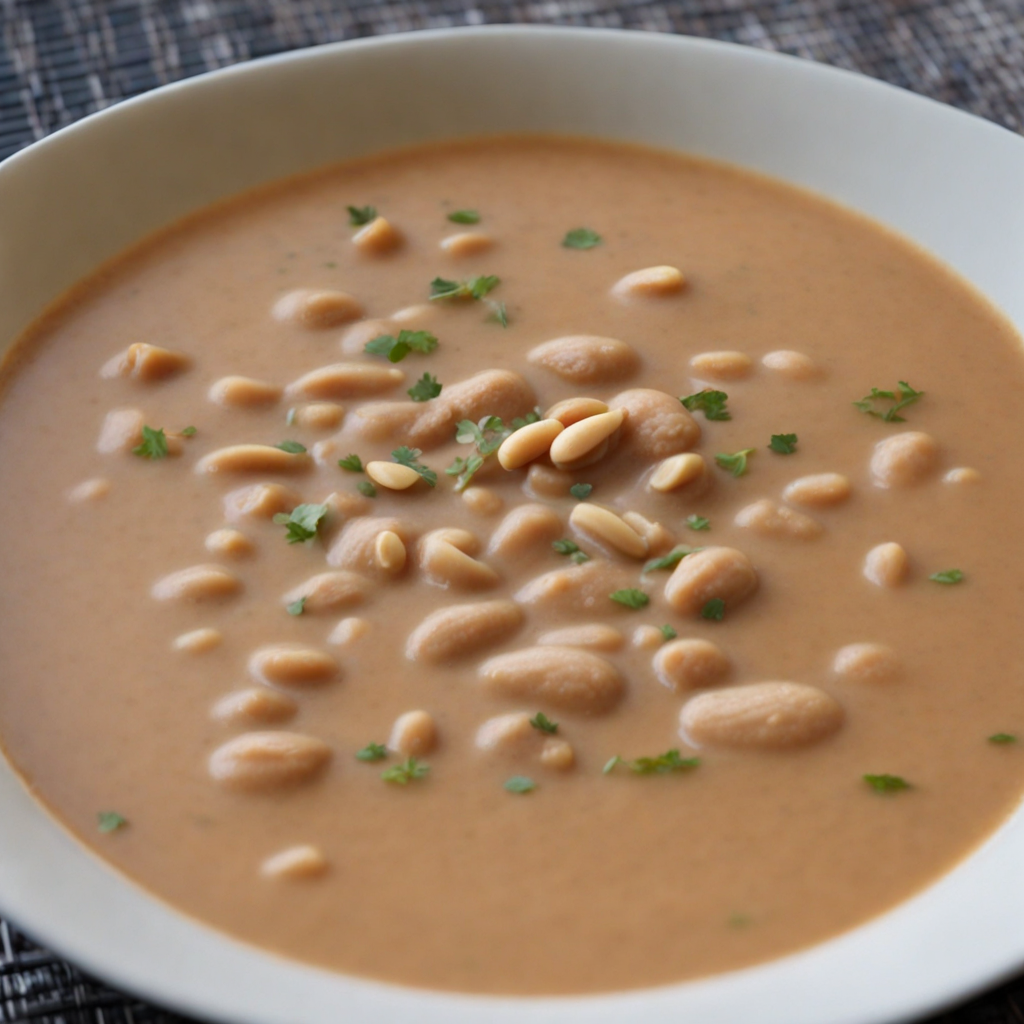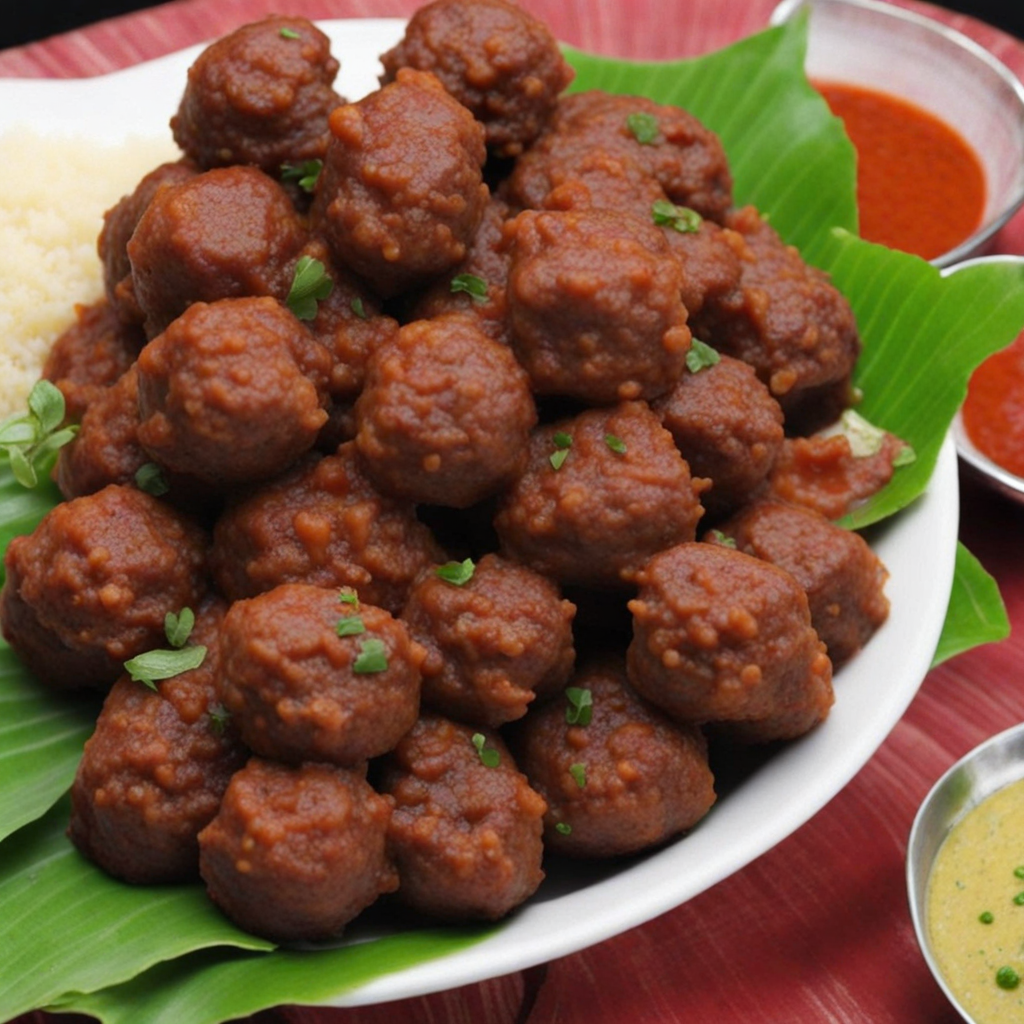Peanut Soup
Peanut Soup, a beloved dish from the Central African Republic, is a rich and hearty concoction that showcases the region’s culinary heritage. This soup is primarily made with ground peanuts, which give it a creamy, velvety texture and a nutty flavor that is both comforting and satisfying. The dish often incorporates a variety of vegetables, such as tomatoes, onions, and sometimes sweet potatoes, which add layers of flavor and nutrients. The blend of spices, including garlic, ginger, and chili, can vary from one household to another, enhancing the soup’s aroma and warmth, making it a perfect comfort food for any occasion. As you take your first spoonful of Peanut Soup, you’ll experience a delightful balance of flavors—the earthiness of the peanuts beautifully complements the sweetness of the tomatoes and the subtle heat from the spices. Each ingredient contributes to a harmonious taste profile that is both simple and complex. The richness of the peanuts provides a satisfying mouthfeel, while the vegetables lend a freshness that brightens each bite. This dish often serves as a filling meal on its own, but it can also be paired with rice or cassava for a more substantial feast. Peanut Soup is not just a meal; it’s a cultural experience that invites you to savor the traditions of the Central African Republic. It is commonly enjoyed in communal settings, where families and friends gather around a large pot, sharing stories and laughter. This dish embodies the spirit of togetherness and hospitality, making each bowl of Peanut Soup a warm reminder of the importance of family and community in Central African culture. Discovering this unique dish will not only tantalize your taste buds but also provide a glimpse into the rich culinary tapestry of the region.
How It Became This Dish
Soupe d'Arachide: A Culinary Journey Through the Heart of Central Africa Origins and Ingredients Soupe d'Arachide, or peanut soup, is a beloved dish in the Central African Republic (CAR) and has its roots deeply embedded in the agricultural practices of the region. The origins of this hearty soup can be traced back to the introduction of peanuts (Arachis hypogaea) to West Africa, likely through transatlantic trade routes in the 16th century. Peanuts, initially cultivated in South America, found their way to Africa where they thrived in the warm, tropical climate. Over time, they became a staple crop, particularly in the CAR, due to their adaptability and nutritional value. The core ingredients of Soupe d'Arachide include ground peanuts, water, and various vegetables. Often, ingredients such as tomatoes, onions, garlic, and leafy greens are added, along with seasonings like salt, pepper, and sometimes chili for heat. The simplicity of the ingredients belies the complexity of flavors that emerge during cooking. It is a versatile dish, with variations tailored to local tastes, available ingredients, and dietary needs. Cultural Significance In the Central African Republic, food is more than mere sustenance; it is a vital part of social identity and cultural expression. Soupe d'Arachide embodies this ethos, often served in family gatherings, celebrations, and communal meals. The act of cooking and sharing this soup fosters connections among family members and friends, reinforcing social bonds and cultural heritage. Peanuts, as a significant source of protein and healthy fats, have historically played an important role in the diets of Central African communities, especially in rural areas where livelihoods are closely tied to agriculture. The soup itself is often considered a comfort food, evoking feelings of home and nurturing. It is not uncommon for families to pass down recipes through generations, each adding their own twist, thus creating a rich tapestry of culinary traditions. Soupe d'Arachide is also indicative of the broader agricultural practices in the region. The reliance on locally available ingredients reflects the importance of food sovereignty and sustainable farming. The dish embodies the principles of resourcefulness and community, as families often grow their own peanuts and vegetables, minimizing reliance on external markets. Historical Development The evolution of Soupe d'Arachide is intrinsically linked to the socio-political landscape of the Central African Republic. The country has experienced periods of turmoil, including colonial rule, civil conflict, and economic instability. Each of these factors has influenced food practices and the availability of ingredients. During the colonial era, foreign powers imposed their agricultural systems, leading to the introduction of new crops and cooking techniques. However, the resilience of the local population ensured that traditional dishes like Soupe d'Arachide retained their place in the culinary landscape. The soup became a symbol of resistance and cultural identity amidst external pressures. In the post-colonial period, as the CAR grappled with its identity and aspirations, Soupe d'Arachide remained a constant. It is often a staple in school feeding programs and community kitchens, highlighting its nutritional value and accessibility. Moreover, various NGOs and local organizations have sought to promote the cultivation of peanuts and the preparation of traditional dishes as a means of economic empowerment and food security. As globalization has influenced food trends, Soupe d'Arachide has gained recognition beyond its borders. Chefs and food enthusiasts worldwide have begun to explore this dish, incorporating it into fusion cuisines and elevating it to gourmet status. This newfound interest has given rise to a modern interpretation of the soup, with chefs experimenting with flavors and presentation while still honoring its traditional roots. Modern Interpretations and Global Influence In contemporary culinary spaces, Soupe d'Arachide has transcended its local origins. With the rise of global food networks and the internet, this dish has found its way into international cookbooks and restaurant menus. Chefs are now exploring creative variations, incorporating elements from different cuisines, such as adding coconut milk, curry spices, or even seafood, while maintaining the essence of the traditional peanut base. In urban areas of the CAR, street vendors serve Soupe d'Arachide as a quick, affordable meal, making it accessible to a broader audience. The soup's popularity has led to its inclusion in various food festivals, cultural showcases, and international culinary competitions, where it is celebrated not just for its taste but also for its cultural significance. The rise of health consciousness has also influenced the perception of Soupe d'Arachide. With its rich nutritional profile, the soup has been embraced by those seeking plant-based diets and comfort foods that also provide essential nutrients. Food bloggers and nutritionists have highlighted its benefits, further solidifying its place in the modern culinary canon. Conclusion: A Reflection of Resilience and Community The story of Soupe d'Arachide is one of resilience, community, and cultural expression. This humble soup encapsulates the spirit of the Central African Republic, reflecting its agricultural heritage, social values, and evolving identity. As it continues to adapt to contemporary tastes and global influences, Soupe d'Arachide remains a cherished dish, embodying the heart and soul of Central African cuisine. In every bowl of Soupe d'Arachide, there lies a story of tradition and innovation, of a people who have weathered challenges while celebrating their culinary roots. As we savor this dish, we partake in a rich history that transcends time and borders, connecting us to the vibrant culture of the Central African Republic and its enduring love for the flavors of home.
You may like
Discover local flavors from Central African Republic







